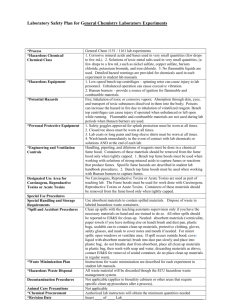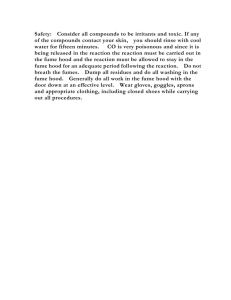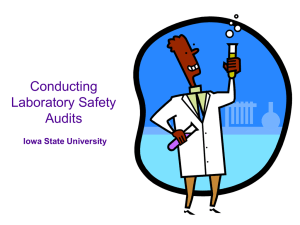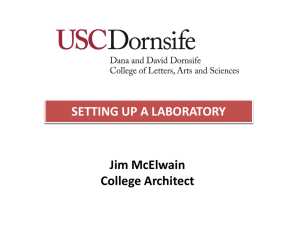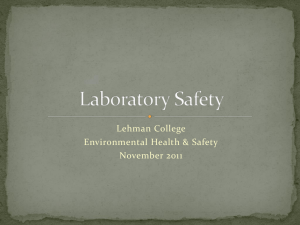Designer`s Checklist - University of Manitoba
advertisement
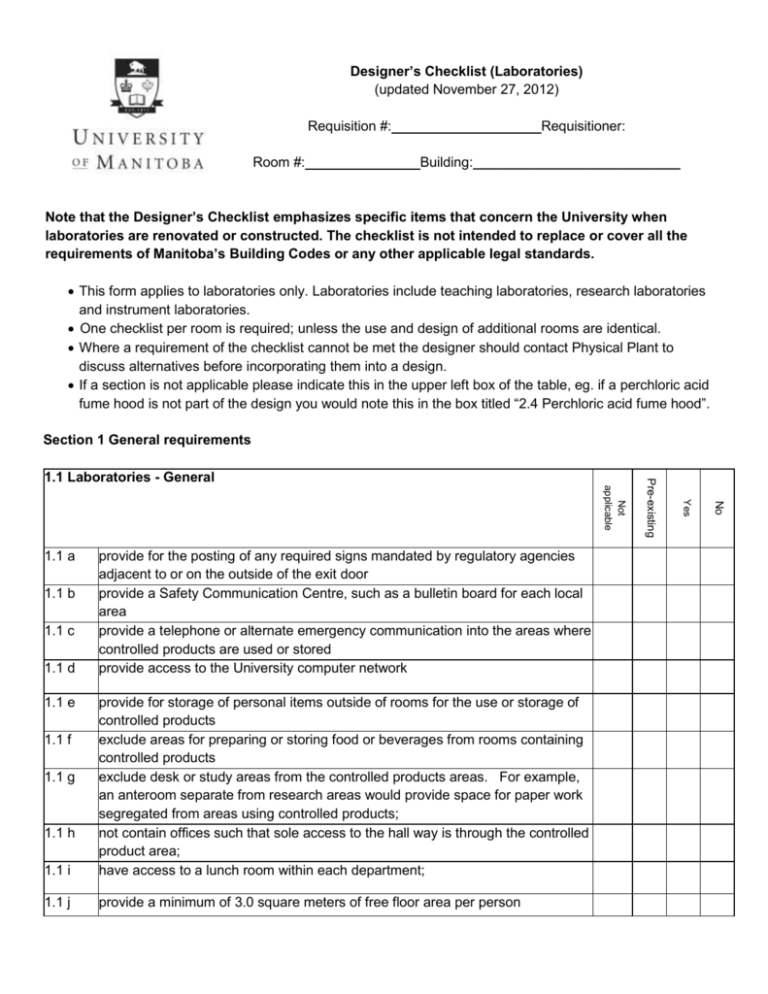
Designer’s Checklist (Laboratories) (updated November 27, 2012) Requisition #: Requisitioner: Room #:_______________Building:___________________________ Note that the Designer’s Checklist emphasizes specific items that concern the University when laboratories are renovated or constructed. The checklist is not intended to replace or cover all the requirements of Manitoba’s Building Codes or any other applicable legal standards. This form applies to laboratories only. Laboratories include teaching laboratories, research laboratories and instrument laboratories. One checklist per room is required; unless the use and design of additional rooms are identical. Where a requirement of the checklist cannot be met the designer should contact Physical Plant to discuss alternatives before incorporating them into a design. If a section is not applicable please indicate this in the upper left box of the table, eg. if a perchloric acid fume hood is not part of the design you would note this in the box titled “2.4 Perchloric acid fume hood”. Section 1 General requirements 1.1 c 1.1 d 1.1 e 1.1 i provide for storage of personal items outside of rooms for the use or storage of controlled products exclude areas for preparing or storing food or beverages from rooms containing controlled products exclude desk or study areas from the controlled products areas. For example, an anteroom separate from research areas would provide space for paper work segregated from areas using controlled products; not contain offices such that sole access to the hall way is through the controlled product area; have access to a lunch room within each department; 1.1 j provide a minimum of 3.0 square meters of free floor area per person 1.1 f 1.1 g 1.1 h No 1.1 b provide for the posting of any required signs mandated by regulatory agencies adjacent to or on the outside of the exit door provide a Safety Communication Centre, such as a bulletin board for each local area provide a telephone or alternate emergency communication into the areas where controlled products are used or stored provide access to the University computer network Yes Not applicable 1.1 a Pre-existing 1.1 Laboratories - General 1.1 o have hallways or corridors of at least one wall of unobstructed egress; 1.1 p be designed to minimize blind spots for reasons of personal safety and emergency egress in all hall ways, stairways and entrances; have doors or partitions in corridors allowing visibility to ensure no one is coming the other way; 1.1 q 1.1 r 1.1 s 1.1 t 1.1 u 1.1 v 1.1 w be designed with consideration given to the egress of an occupant in the event of an emergency. Hazardous activities shall be carried out in locations leaving unobstructed egress; provide rapid escape from cold rooms and walk in incubators in the event of a electrical failure; provide for hanging up lab coats or other coveralls and any other required personal protective apparel close to the exit of the room; be equipped with appropriate fire extinguishers; meet the requirements for a separate fire compartment having a fire separation of not less than 1hour; include at least one fume hood (see section on fume hoods); 1.2 Finishing and Fixtures: 1.2 a 1.2 c have flooring that is seamless, impervious, resistant to chemicals and provide a washable surface with a strippable coating. Carpets will not be permitted. This requirement is extended to the corridor outside; have all joints in the flooring material sealed. Junctions between floor and vertical surfaces (walls and permanently placed fixtures such as fume hoods) shall be smooth, coved and continuous with floor; have walls that provide a smooth, impervious and washable surfaces; 1.2 d have ceilings that are washable or made of tiles that are replaceable; 1.2 b No 1.1 n No have aisle spaces of more than 1 meter (40 inches) wide. The aisles should lead as directly to a means of egress; be designed to minimize sound exposure to all workers through the selection and location of equipment and noisy processes. Yes 1.1 m Yes provide a grounding strap for decanting flammable material Pre-existing 1.1 l Pre-existing provide for emergency lighting in controlled products areas; Not applicable 1.1 k Not applicable 1.1 Laboratories - General No No 1.2 i 1.2 j have patient wash rooms finished in materials that are easily decontaminated; 1.3 Plumbing: 1.3 b provide separate sinks for hand washing and for a wash up sink in laboratories. The hand washing sink should be located near the laboratory exit. The wash up sink should be located in a low traffic area adjacent to the work area have sinks made of a material that is readily decontaminated; 1.3 c have sinks with overflow protection; 1.3 d 1.3 f have water taps on hand washing sink that may be operated by means not requiring direct hand contact have back flow protection devices on all faucets with vacuum or cooling line attachments; connect the wash up sink drain only to other wash up sink drains; 1.3 g have the drain from all sinks go directly to the main building sewer. 1.3 h not include any dilution or neutralization tanks; 1.3 i have all sink drain traps accessible; 1.3 j have drains that are chemical resistant. 1.3 k have an emergency eye wash and safety shower that meets, and is installed as required by, ANSI Standard Z358.1 (most current version). The eyewash and safety shower shall be located at least 1.2 meters (6 feet) from any electrical outlets or circuits. 1.3 e Yes have counter surfaces that are smooth, impervious, chemically resistant, washable and can be easily decontaminated. Surface laminates shall be chosen from water and chemical resistant products; Laboratory chairs shall be made of material that is smooth, impervious, chemically resistant, washable and can be easily decontaminated. No fabric or carpet like material permitted; have all joints on counters sealed; have cupboards and shelving with smooth, impervious, chemical-resistant and washable finishes. Exposed shelving shall be kept to a minimum to prevent dust accumulation; have light fixtures that are enclosed to be easy to clean; 1.3 a Yes 1.2 h Pre-existing 1.2 g Pre-existing 1.2 f Not applicable 1.2 e Not applicable 1.2 Finishing and Fixtures: provide locks on doors (padlocks require a variance); 1.5 b be designed such that any ground floor windows prevent access from the outside; have locks on the exterior door of the research area or building that may be set after normal business hours to lock automatically behind you upon exit; 1.5 c 1.5 d No 1.5 a No 1.5 Security : No 1.4 g Yes Provide facilities for storing wastes generated daily provided within the laboratory; Provide an area for the accumulation of wastes prior to disposal that is isolated from occupied areas. Yes 1.4 f Yes Provide ventilation for the storage of materials that may give rise to aerosols or gases Pre-existing 1.4 e Pre-existing Provide appropriate segregation of incompatible materials; Pre-existing 1.4 d 1.4 b Not applicable 1.4 c Include a storage area for the controlled products that will be used in the room. Provide glass covered cabinets for chemical storage that are of solid and sturdy construction, hardwood or metal shelving is preferred. Shelves shall be properly anchored. All laboratories shall have storage space for supplies and combustibles such as boxes of gloves and centrifuge tubes etc. Laboratories using free standing gas cylinders shall be constructed to provide areas and equipment to properly secure gas cylinders Comply with the flammable and combustible liquids storage requirements of section 5.5.5 of the Manitoba Fire Code Provide a flammable materials storage refrigeration unit if required; Not applicable 1.4 a Not applicable 1.4 Storage have a lockable storage area (cupboard, fridge or freezer) provided for specific controlled products (such as radioactives, ethanol (95% and absolute), narcotics). Section 2 Ventilation 2.1 General Ventilation 2.1 a Air flows are from less contaminated areas to areas presumed to have higher levels of contamination, eg. air from a hallway would leak into a laboratory. 2.1 c All air supplied to a laboratory must be exhausted outside the building be designed to capture exhaust fumes, aerosols or gases that are hazardous or explosive at the source Flow rates through local exhaust systems are maintained 24/7. The only exception will be teaching laboratories where no controlled products are present except during scheduled laboratory sessions. include a readily visible flow-measuring device; 2.2 c 2.2 d 2.2 e 2.2 f 2.2 g 2.2 h Can not be interlocked with fire detection and alarm systems to shut down automatically upon alarm; be connected to an exhaust duct that has: been constructed of corrosion-resistant material; has all joints smoothly finished and sealed; at least 1% slope back towards the hood; bends of long sweep and accessible for inspection; not interconnected to fume hood exhaust; only have the exhaust ducts manifolded if: EHSO has been consulted; the hoods are not perchloric acid hoods deposits, or highly hazardous residues will not accumulate in the duct work the exhaust does not require HEPA filtration or other special cleaning the exhaust ducts are joined in a fire rated shaft, or mechanical room, or outside of the building at the roof line. all air exhausted through a local exhaust system must be exhausted outside the building No 2.2 b Yes be designed to eliminate back draft; Preexisting 2.2 a Not applicable 2.2 Local exhaust general requirements No Total exhaust rate exhaust (including both general and local exhaust) of 1.0 cubic feet per minute per square foot of floor space which will be maintained 24/7 Yes Not applicable 2.1 b Pre-existing 2.1 General Ventilation No No 2.3 c Yes 2.3 b Yes have the exhaust fan motor: placed close to the discharge point in order to maintain negative pressure in the duct work within the building; mounted outside the exhaust duct for easy access and to avoid contamination; if the motors are located in an equipment room the equipment room shall be ventilated; noise from the fume hood fan shall not be more than 65dBA at the face of the capture point; discharge exhaust vertically without obstruction eg. rain cap or goose neck, with a discharge velocity of a least 3000 feet per minute. Discharge will occur at least 3 meters above and 10 meters horizontally from any air intake. The stack arrangement, height, discharge, velocity and location must ensure acceptable dilution, dispersion and elimination of re-entry into buildings. have the fan, duct, breaker and motor identified for the respective fume hood and room number. 2.3 Fume Hoods 2.3 a Pre-existing 2.2 k Preexisting 2.2 j Not applicable 2.2 i Not applicable 2.2 Local exhaust general requirements Fume hoods must meet the design and construction requirements of the most current version of CSA Z316.5 “Fume hoods and associated exhaust systems” Have the linear face velocity between 0.4 and 0.6 meter/second (80 - 120 linear feet per minute, with a minimum of 80 LFM at any measured point) with the sash at 11 inches. There shall be a balanced air feature such that the fume hood is vented even if the sash is closed; Ductless fume hoods: portable, non-ducted chemical fume hoods are not permitted. Yes No Yes No be located: in a remote area of the facility away from exits and traffic flow. The hoods should be located more than 1.5 meters (5 feet) from any door or doorway; more than 3 meters (10 feet) from face to face if installed opposite a biological safety cabinet; so that any room air supply diffuser is more than 1.5 m (5ft) of the sash and the room diffuser shall not affect fume hood performance. None the less, the air supply shall not create room air drafts at the face of any hood greater than half the face velocity of the hood; so that an unobstructed personal work area extends at least 1.5 m (5 ft) from the face of the fume hood; so that the workstation opposite the face of the cabinet is not one where personnel are likely to spend much of their working day (such as a desk or microscope bench); so that the sash is at least 2 m (6.6ft) from an opposing wall or other obstruction likely to affect the air flow; so that the distance from the side of the hood and the wall (or any architectural structure) projecting past the plane of the sash should be at least 0.3m (1foot); not have any heated drying base cabinets (drying ovens) under fume hoods; have incorporated venting of storage cabinets for controlled products that are located under the fume hood. Venting shall be at floor level and at the top. The storage cabinets under the fume hood shall be vented using stainless steel ducting connected above the hood and the exhaust duct collar. All penetrations shall be sealed. The storage cabinets should have corrosionresistant interiors and piping to meet the requirements of ANSI/NFPA 30 and 45 for flammable storage 2.4 Perchloric Acid Fume Hood 2.4 a have all surfaces of the hood comprised of materials that do not react with the acid to form flammable or explosive compounds; 2.4 b be equipped with water wash down capabilities to wash the interior surfaces of the entire hood, duct, fan and stack surface; 2.4 c be equipped with duct work of Type 316 stainless steel with smooth-welded seams and shall take the shortest, direct, straight path to the outside of the building; not be manifolded; 2.4 d Pre-existing 2.3 f Pre-existing 2.3 e Not applicable 2.3 d Not applicable 2.3 Fume Hoods not be located in high traffic areas; 2.6 b be constructed of materials that are fireproof (with exception of gloves and gasket materials), and with surfaces that are impervious, corrosion-resistant for the intended use, and easily cleanable. Interior cracks at seams and joints should be eliminated or sealed; be designed such that utility valves and switches shall be external and conform with applicable codes; 2.6 c 2.6 d provide spill containment for the maximum volume used; 2.6 e be provided with exhaust ventilation to result in a pressure inside the box that is at least 0.1" w.g. negative with respect to the room when all openings are closed, and at least 100 fpm inward air velocity when the largest operating opening are open; include a pressure relief valve; 2.6 f 2.6 g be designed to clean exhausted air or gases, if necessary, and discharged to the outside atmosphere; 2.6 h be connected to exhaust ducts in accordance with the ACGIH Industrial Ventilation Manual, ANSI Z9.2; 2.6 i if perchloric acid used meet the relevant requirements for perchloric acid fume hoods (Section 2.4). No 2.6 a No 2.6 Glove Boxes No include a pan retainer deep enough to hold the volume of liquids intended for use in the work. Yes 2.5 b Yes not have a floor drain; Yes 2.5 a Pre-existing 2.5 Walk-In Fume Hoods Pre-existing have an exhaust fan that is acid and spark resistant. The exhaust fan motor shall not be located within the duct work. Drive belts shall be conductive and shall not be located within the duct work. Pre-existing 2.4 f Not applicable have the hood and duct work labeled "Perchloric Acid Hood"; Not applicable 2.4 e Not applicable 2.4 Perchloric Acid Fume Hood Yes No Yes No Yes No not be installed as an integral part of a room(s)supply and exhaust system in such manner that fluctuations of the room supply and exhaust air cause the biological safety cabinets to operate outside their design parameters for containment. be located away from doors, from windows that can be opened, from room supply air diffuser and from heavily-traveled laboratory areas. be located to achieve the recommended minimum of 30cm clearance, behind each side of the cabinet to permit cleaning and testing and a minimum unobstructed clearance of 40 cm at the exhaust filter discharge to permit testing. be installed and tested in accordance with most current version of CSA Z316.3 or National Sanitation Foundation Standard 49 HEPA-filter any cabinet air prior to re-circulation. 2.8 Class IIB Biological Safety Cabinets 2.8 a not be used as the sole source of room exhaust 2.8 b have the room supply air system equipped with dampers to prevent back-flow when biological safety cabinets are connected to exhaust duct work. be connected to exhaust duct by thimble units where appropriate and room exhaust ducts are equipped with manual dampers to permit sealing for decontamination. Manufacturer’s recommendations for installation of BSC should be carefully followed. 2.8 c Pre-existing 2.7 e Pre-existing 2.7 d Pre-existing 2.7 c Not applicable 2.7 b Not applicable 2.7 a Not applicable 2.7 Biological Safety Cabinets Section 3 Radioisotope Laboratories 3.1 General requirements 3.1 a 3.1 b have “Radioactive” sink drains: marked at 3 meter intervals with the first marker readily visible to maintenance personnel. identified on building plans supplied to maintenance personnel; provide for installing an appropriate radiation monitoring device as required Yes No Yes No Pre-existing 3.1 e Pre-existing 3.1 d Discipline 3.1 c Not applicable 3.1 General requirements If a fume hood is required (must meet requirements of section 2.2 and 2.3 above) designed to support any shielding required; have the exhaust duct marked at 3 meter intervals with the radiation warning symbols with the first marker readily visible to maintenance personnel. (only fume hoods so marked will be approved for the use of radioactive materials); have exhaust ducts from fume hoods in radioisotope laboratories identified on building plans supplied to maintenance personnel; be designed so that radioiodination laboratories or radioactive iodine storage areas and shall be at negative pressure with respect to all adjacent areas provide appropriate shielding for radioactive materials storage areas Section 4 Controlled Climate and Walk-In Cold Rooms 4.1 General requirements 4.1 a 4.1 b 4.1 c provide ventilation during periods of personnel occupancy (EHSO consultation is required); have latches that can be operated from the inside to allow escape that function under all design conditions. Magnetic latches are recommended; have doors with viewing windows and external light switches Design Stage Declarations EHSO approval at the DESIGN STAGE is required for an Internal Radioisotope Permit to be issued later. Design Personnel (name, employer, and phone numbers): Architectural Personnel: ………………………………………………………………………. Mechanical Personnel: ………………………………………………………………………. Electrical Personnel: ………………………………………………………………………. Plumbing Personnel: ………………………………………………………………………. Date:

